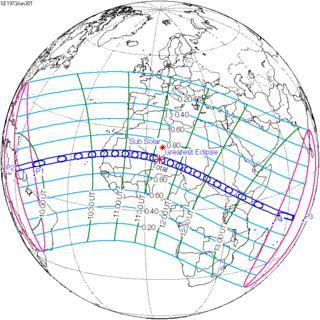Nature Total Magnitude 1.0792 Max. width of band 256 km (159 mi) Start date June 30, 1973 | Gamma -0.0785 Duration 424 sec (7 m 4 s) Greatest eclipse 11:38:41 | |
 | ||
A total solar eclipse occurred on June 30, 1973. A solar eclipse occurs when the Moon passes between Earth and the Sun, thereby totally or partly obscuring the image of the Sun for a viewer on Earth. A total solar eclipse occurs when the Moon's apparent diameter is larger than the Sun's, blocking all direct sunlight, turning day into darkness. Totality occurs in a narrow path across Earth's surface, with the partial solar eclipse visible over a surrounding region thousands of kilometres wide.
Contents
With a maximum eclipse of 7 minutes and 4 seconds, this was the last total solar eclipse that exceeds 7 minutes in this series. The last total eclipse over 7 minutes was on July 1, 1098 which lasted 7 minutes and 5 seconds. There will not be a longer total solar eclipse until June 25, 2150.
The greatest eclipse occurred in the Agadez area in the northwest of Niger not far from Algeria inside the Sahara Desert somewhat 40 km east of the small mountain of Ebenenanoua at 18.8 N and 5.6 E and occurred at 11:38 UTC.
The umbral portion of the path started in Guyana, headed into the Atlantic, included one of the Cape Verde Islands, which was Santo Antão, Nouadhibou and Nouakchott and other parts of Central Mauritania, northern Mali, the southernmost of Algeria, the middle and southeastern Niger, the middle of Chad, the Sudan including Darfur and parts that are now in the South Sudan including Kodok, a part of the northernmost Uganda, a part of northern Kenya and the southernmost of Somalia.
Observations
This eclipse was observed by a group of scientists from the Los Alamos National Laboratory using two airplanes to extend the apparent time of totality by flying along the eclipse path in the same direction as the Moon's shadow as it passed over Africa. One of the planes was a prototype of what was later to become the Concorde, which has a top speed of almost 1,300 miles per hour (2,100 km/h)(Mach 2). This enabled scientists from Los Alamos, the Paris Observatory, the Kitt Peak National Observatory, Queen Mary University of London, the University of Aberdeen and CNRS to extend totality to more than 74 minutes; nearly 10 times longer than is possible when viewing a total solar eclipse from a stationary location. The data gathered resulted in three papers published in Nature and a book.
The eclipse was also observed by a charter flight from Mount San Antonio College in Southern California. The DC-8 with 150 passengers intercepted the eclipse at 35,000 feet (11,000 m) just off the east coast of Africa and tracked the eclipse for three minutes. The passengers rotated seats every 20 seconds so that each passenger had three 20 second opportunities at the window to observe and take pictures. A separate observation opportunity was provided on a specialized commercial cruise by the S.S. Canberra, which traveled from New York City to the Canary Islands and Dakar, Senegal, observing close to 8 minutes of totality out in the Atlantic between those two stops in Africa. That cruise's passengers included notables in the scientific community such as Neil Armstrong and Isaac Asimov.
Solar eclipses of 1971-1974
Each member in a semester series of solar eclipses repeats approximately every 177 days and 4 hours (a semester) at alternating nodes of the Moon's orbit.
Note: Partial solar eclipses on February 25, 1971 and August 20, 1971 occur in the next lunar year set.
Saros 136
Solar Saros 136, repeating every 18 years, 11 days, contains 71 events. The series started with partial solar eclipse on Jun 14, 1360, and reached a first annular eclipse on September 8, 1504. It was a hybrid event from November 22, 1612, through January 17, 1703, and total eclipses from January 27, 1721 through May 13, 2496. The series ends at member 71 as a partial eclipse on July 30, 2622, with the entire series lasting 1262 years. The longest eclipse occurred on June 20, 1955, with a maximum duration of totality at 7 minutes, 8 seconds.
Metonic series
The metonic series repeats eclipses every 19 years (6939.69 days), lasting about 5 cycles. Eclipses occur in nearly the same calendar date. In addition the octon subseries repeats 1/5 of that or every 3.8 years (1387.94 days).
